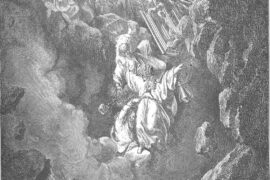Whenever any subjugated people attains its liberation, the healthy next step should be to engage in a postcolonial conversation. This holds especially true for a people that was not only conquered and oppressed but also suffered displacement and persecution for many centuries before somehow returning home and regaining independence.
Returning to a reality of self-determination nearly two thousand years after the Roman Empire smashed our national framework and exiled us from our homeland requires us to figure out the best means of applying our people’s authentic values and aspirations to a healthy 21st Century nation-state.
This process obviously involves examining – and in some cases throwing off – some of the foreign practices and habits picked up in the exile – especially in situations when those practices and habits resulted from persecutions, social pressures and other forms of external coercion.
But when attempting to decolonize and clarify our people’s identity, it’s important to distinguish between changes to Jewish practices and social norms based on internal cultural evolutions (as inevitably happens to all peoples overtime) and external coercion (persecution, fear of persecution, pressure or desire to assimilate into host nations, etc.). And while there are several aspects of Jewish culture and identity in need of deeper analysis, decolonization and – in some cases – alteration, we cannot include within this category the Ashkenzani ban on eating kitniyot (legumes) during Pesaḥ.
Despite having taken place in the Diaspora, the kitniyot ban was enacted not due to fear of persecution or a desire to better fit in with host populations but rather due to a genuine concern that eating kitniyot would potentially cause Jews to inadvertently eat ḥametz. Rather than further distance us from our people’s values, the ban was essentially a display of passion for – and loyalty to – those values.
Part of recognizing the importance of the kitniyot ban even in our day (when no legitimate concern exists that eating kitniyot could potentially cause one to eat ḥametz) requires us to appreciate the true significance of minhagei Yisrael – customs the nation of Israel (or sectors of the nation) take upon ourselves – which on the surface may often appear to be obscure archaic stringencies but are in reality so much more.
Laws, customs and practices that Israel decides to accept are actually earthly expressions of higher occurrences taking place in the spiritual realm. One of the amazing aspects of our Torah is that it’s not static but actually alive and dynamic – the rules of decision making are such that the decisions themselves are in many cases actual expressions of higher mystical concepts – even when the scholars or communities making these decisions are completely unaware of this metaphysical reality.
Israel’s laws and customs possess incredible cosmic significance way beyond the revealed reasons for which they were ostensibly established.
A perspective of emuna recognizes that events and historical developments are not random. When there are doubts that bring about new laws, customs and stringencies, the doubts are not the actual cause for the new laws/customs/stringencies but rather the new laws/customs/stringencies are suddenly necessary to serve a higher purpose, fill a void and compensate for a deficiency caused by our lower moral and/or spiritual standing.
For example, the fact that Diaspora Jews are still required to observe two days for certain festivals while we here in Eretz Yisrael observe only one shows that there must be a purpose to this minhag beyond merely doubting the time of the new moon (obviously no longer an issue). In fact, the doubt surrounding the new moon had been Divinely orchestrated in order to bring about the custom of an additional day, which is necessary to compensate for a specific deficiency Diaspora Jews experience by living outside their land/natural habitat.
The fact that we no longer have any doubt over the time of the new moon creates a situation in which the rational earthly reason for this specific minhag seems to no longer apply, yet this is by no means sufficient grounds for anyone to annul the custom.
The situation is not the reason for the laws/customs/stringencies but rather the need for the new laws/customs/stringencies is the inner reason for the situation – the inner need for the law/custom/stringency is the reason that history brings about the doubt (see Rabbi Avraham Yitzḥak HaKohen Kook’s Ein Aya, Shabbat vol I p. 25). Since another day of yom tov is necessary in exile, it worked out that there would be calendar-related doubts that would then require a second day of yom tov for Diaspora Jews.
For whatever reason, Ashkenazim require a ban on kitniyot in order to rectify a unique spiritual deficiency. When that deficiency is overcome and no longer exists on the higher plane, the ban will be lifted. But so long as the ban remains in effect, we should oppose those actively fighting to annul it according to the calculations of their limited human intellect (or in some cases merely their desire to eat kitniyot during Pesaḥ).
Another argument often advanced in favor of lifting the kitniyot ban is Jewish unity. But we must be careful not to confuse unity with uniformity. The nation of Israel is one body – actually one giant spiritual organism shining into this world through millions of bodies in space and time called Jews. And just like a single body, it is made up of different limbs and organs with different functions. Nutrients that can be healthy and necessary for one can theoretically be damaging for another. Some vehicles require 95 octane to function properly while others require diesel fuel. Each motor needs that which best suits it.
Different limbs of Israel may require different enhancements. Just to show an example of the distinction between the different parts of the unified Israeli national organism, the Ḥida (Rav Ḥaim Yosef David Azulai) teaches that Mizraḥim are spiritually rooted in the power of ḥesed and Ashkenazim in the power of din. This may create different spiritual needs (such as increased sliḥot, piutim or not cooking fish with dairy).
Mizraḥim never required a ban on kitniyot but Ashkenazim did and apparently still do. Israel’s deep inner unity does not imply or demand uniformity but rather the recognition for how each of the different parts complement one another to harmoniously make up the unified Israeli organism.
A good example might be the various nusaḥim of tefilla. The idea of creating a uniform nusaḥ may be appealing and seem correct on the surface, but when we explore the issue deeper we discover that the various nusaḥim exist for a reason. We learn there to be twelve “gates” of tefilla. Each of the twelve Hebrew tribes has its own unique gate and therefore one is not to change his custom in order to “unify” with the other, since that could result in some Jews trying to connect through “gates” not suited for their spiritual constitution (see Ḥatam Sofer, Oraḥ Ḥaim 16).
Ashkenazim require a ban on kitniyot in order to rectify a unique spiritual deficiency apparently not relevant to other Jews. When that deficiency is healed, the ban will be lifted. But the battle to prematurely annul the ban often seems like part of a larger trend by those seeking to “update” Jewish life – as if our Torah is merely a collection of impressive human ideas from the past and not the Divine Ideal from before Creation lowered into our world to reveal the ultimate goal for mankind.





